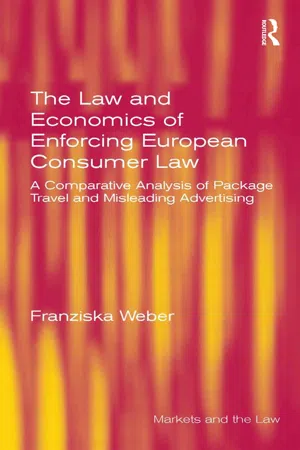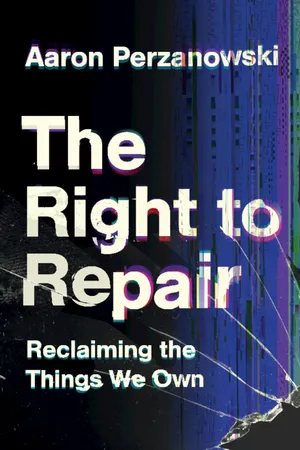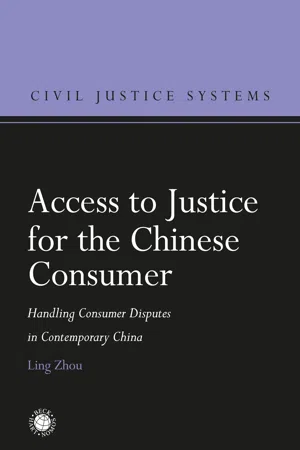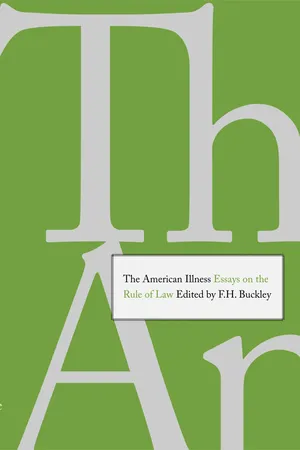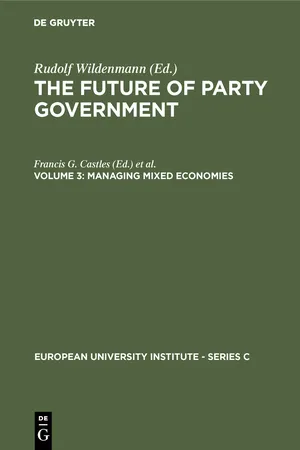Economics
Consumer Protection
Consumer protection refers to the laws and regulations designed to safeguard consumers from unfair or deceptive business practices. It aims to ensure that consumers have access to accurate information, fair treatment, and recourse in case of product or service issues. Consumer protection measures often include product safety standards, truth in advertising requirements, and mechanisms for resolving consumer complaints.
Written by Perlego with AI-assistance
Related key terms
1 of 5
8 Key excerpts on "Consumer Protection"
- eBook - ePub
- Geraint Howells, Stephen Weatherill(Authors)
- 2017(Publication Date)
- Routledge(Publisher)
It covers law which sustains, promotes, curtails and adjusts the structure of a free market. In many cases it is based on political perceptions of the nature of the market economy. Within an overall political acceptance of the desirability of a market economy, there are many nuances of approach towards the way that market should be permitted to operate, with law used to achieve such adjustments. However, an accumulation of legal rules introduced by governments of different political complexions in the UK over many years has left the law of the economy in a patchwork state. Consumer Protection law can be understood only against such backgrounds. The consumer’s place in the economy and in society attracts differing interpretations. Consumers are, after all, a heterogenous bunch and for most people it is probable that no theory feels intuitively completely correct or completely incorrect. Different perspectives contain their own truths. The law is affected by choices made about the identity of the consumer and the role he or she is supposed to play in the economy and in society. Consumer Protection law has a range of possible rationales, some of which may conflict. The modern law has grown by accretion. The law now protects the consumer from a lot of different things in a lot of different ways and, as the law of market regulation has accumulated over the centuries since the days of the aleconner and obligatory cheap corn supply, 5 for a lot of different reasons. Consumer Protection law is susceptible to neither neat nor narrow definition. Its scope is open-ended. It embraces both private law and public law; it requires appreciation of both national and transnational law. Consumer law sometimes appears self-contained – an example is provided by the EC’s making of a distinctive consumer contract law – while elsewhere it forms part of broader commercial law - eBook - ePub
The Law and Economics of Enforcing European Consumer Law
A Comparative Analysis of Package Travel and Misleading Advertising
- Franziska Weber(Author)
- 2016(Publication Date)
- Routledge(Publisher)
1 Introduction DOI: 10.4324/9781315556277-1Context: The Need for Consumer Protection Laws and their Enforcement
The starting point for an economic analysis of consumer law enforcement is the existence of markets for consumer goods. Economic theory illustrates how these markets work. In perfectly working markets, no legal interventions (such as tax laws or subsidies) are necessary, as they can only lead to a reduction of economic efficiency. In economic terms, this situation is called a ‘first-best solution’, which is an ideal situation that does not exist in reality. The real world is full of market distortions and imperfections that necessitate legal intervention through Consumer Protection laws. Legal interventions are referred to as second or third-best solutions.In the 1960s and 1970s, consumer movements strongly favoured strengthening the rights of the weak party, and pure legal literature today still includes the argument that the consumer primarily must be protected from powerful (superior) sellers. Law and economics scholars criticised this reasoning.1 They analysed Consumer Protection rules in three different, consecutive streams, namely information economics, new institutional economics and behavioural economics.2 In information economics, the consumer is regarded as exposed to certain constraints due to a lack of information. For instance, the consumer cannot appropriately perceive quality differences.3 Imperfect information and the resulting information costs prevent the consumer from making an informed choice. This first stream shows how information affects people’s ability to make choices, and, consequently, how an improvement in the information flow can solve problems in markets. Solutions do not necessarily have to come from governmental intervention, but can be achieved by internal market mechanisms.1 See G.K. Hadfield , R. Howse and M.J. Trebilcock, ‘Information-Based Principles for Rethinking Consumer Protection Policy’, Journal of Consumer Policy - Gian Antonio Benacchio, Barbara Pasa(Authors)
- 2005(Publication Date)
- Central European University Press(Publisher)
CHAPTER I Consumer Protection and the Law of Contracts KEY WORDS : Consumer Protection – Historical Development – Community Intervention – Implementation – Member States – CEECs – Consumer Contracts – Taxonomy – Limits – Contracts negotiated away from business premises – Package travel, package holidays, and package tours contracts – Unfair terms – Timesharing – Distance sellings – Injunctions – Cross-border disputes – Sale of consumer goods and associated guarantees – Electronic signatures – E-commerce 1. Social and Economic Policy in Consumer Protection “Consumerism” is the term denoting the social phenomenon which plays a central part in the protection of individuals who are consumers in the context of the organization of the global market. A standardized definition of consumer is difficult to identify: in legal terms, a consumer is a natural person who acquires goods or services to meet personal or family needs, but not professional ones. As defined in terms of economics and social sciences, the consumer is a passive ele-ment in the system of mass production and distribution, given the supe-rior bargaining power of business, and is exposed to the external stimuli of a market aimed at influencing her/his choice. The movement started in the United States during the first decades of the 20 th century, with the founding of the first Consumer Union. Mid-way through the last century, “consumerism” achieved its first concrete results, when what had been merely isolated socio-political instances became leading precedents or important legislative or administrative provisions. The issues arising in the areas of commercial advertising, standard con-tracts and product liability were the first to engage the attention of the U.S . courts. The legal solutions which they reached have formed the basis of reference to which European legal systems have looked when develop-ing their own systems of protection.- eBook - PDF
The Right to Repair
Reclaiming the Things We Own
- Aaron Perzanowski(Author)
- 2022(Publication Date)
- Cambridge University Press(Publisher)
In the United States, consumer-protection law embraces a constellation of related and overlapping federal and state statutes. Broadly, these laws are meant to empower regulators and consumers to push back on deceptive, unfair, and abusive practices in the marketplace. Some, like the Federal Trade Commission Act, confer broad authority to regulators to police market behavior. 1 Others, like the Fair Debt Collection Practices Act, set rules for very specific marketplace interactions – in that case, banning debt collectors from contacting consumers “at any unusual time or place.” 2 These laws can be enforced by federal agencies, like the Federal Trade Commission (FTC) and the Consumer Financial Protection Bureau, or state-level con- sumer affairs departments and attorneys general. And in many instances, consumers can bring claims directly. Similarly, European law incorporates both broad standards and sector- specific prohibitions at both the EU and national levels. 3 Many of the restrictions on repair we’ve seen implicate con- sumer-protection laws. Misleading statements or omissions about product reparability might constitute deceptive trade practices. Failures to make repair parts available can violate state statutory guarantees. And the common practice of threa- tening to void warranties because of independent repair runs contrary to established federal law. Device makers may insist that consumers are best protected by tightly controlled repair markets. But the law recognizes that device makers themselves may well pose the most serious risks to consumers. Consumer Protection offers powerful and applicable legal tools that could defend independent repair, but they have not been effectively utilized by the FTC and state attorneys general. Clearer guidance and more vigorous enforcement efforts could go a long way towards curbing some of the most abusive tactics device makers deploy. - eBook - ePub
Access to Justice for the Chinese Consumer
Handling Consumer Disputes in Contemporary China
- Ling Zhou(Author)
- 2020(Publication Date)
- Hart/Beck(Publisher)
2 Consumer Protection in China I. Introduction This chapter introduces the social and legal context of the empirical research used in the present study. It considers in particular the ways in which consumer rights and interests are protected by laws and policies in contemporary China. The chapter first explores Consumer Protection issues that arise in China as a result of problems in the PRC’s complicated social and economic transition to the ‘market’. Next, it looks in greater depth at the ‘consumer citizen’ concept, in which consumers pursue a more explicitly political agenda in their quest to secure their economic and civil rights and interests as consumers, and explores its relevance for China. This is followed by an introduction to the field, the city of Shenzhen, in Southern China, where in-depth ethnographic research was conducted. II. The Chinese Context As I have argued in chapter one, Consumer Protection is often needed in market economies, because of the limitations of the market, especially in terms of provision of adequate information, and the availability of user-friendly, affordable private law remedies. These put the consumer in a disadvantaged position when bargaining with producers or sellers. In the case of China which, since 1980, has been increasingly committed to a market-based economy, this justification is also relevant - eBook - PDF
The American Illness
Essays on the Rule of Law
- F. H. Buckley(Author)
- 2013(Publication Date)
- Yale University Press(Publisher)
361 T he past few decades have seen a dramatic rise in state Consumer Protection legislation. Beginning in the early 1960s, these laws arose from a perception that market forces, the Federal Trade Commission (FTC), and state common law did not protect consumers ad-equately. State legislatures responded by enacting a diverse collection of statutes, commonly referred to as Consumer Protection Acts (CPAs), most of which were originally intended to supplement the FTC’s objectives of protecting consumers from “unfair or deceptive acts or practices.” 1 By 1981, all states had their own version of a CPA. The federal government has returned to the field with the Dodd-Frank Act, 2 which regulates nearly every aspect of the financial services industry and consolidates all federal Consumer Protection duties in a single agency: the Consumer Financial Protection Bureau (CFPB). The statute was the product of a perfect storm: the onset of the financial crisis, the rise of be-havioral law-and-economics, and the broader interpretation of state CPAs— which had already expanded the scope of Consumer Protection. Combined, these forces have proved potent. Yet despite the meteoric rise in Consumer Protection legislation, it is unclear that consumers are better off. On the one hand, consumer protec-tion laws help solve such problems as the informational asymmetries The Dramatic Rise of Consumer Protection Law JOSHUA D. WRIGHT AND ERIC HELLAND 362 joshua d. wright & eric helland between well-informed manufacturers and poorly informed consumers. On the other hand, expanded liability can also increase prices beyond what consumers would be willing to pay and deter pro-competitive conduct. Empirical evidence suggests that Consumer Protection legislation often fails to account for two factors: (1) the significant costs of regulation, both intended and otherwise, that are passed on to consumers, and (2) the sound and rational reasons why consumers borrow. - eBook - PDF
- Richard Mann, Barry Roberts(Authors)
- 2019(Publication Date)
- Cengage Learning EMEA(Publisher)
1022 Consumption is the sole end and purpose of production; and the interest of the producer ought to be attended to only so far as it may be necessary for promoting that of the consumer. ADAM SMITH, WEALTH OF NATIONS (1776) 1. Describe the role of the Federal Trade Commission (FTC) and the major enforcement sanctions that it may use. 2. Describe the role and workings of (a) the Consumer Product Safety Commission (CPSC) and (b) the Consumer Financial Protection Bureau (CFPB). 3. Explain the principal provisions of the Magnuson-Moss Warranty Act and distinguish between a full and a limited warranty. 4. Describe what information a creditor must provide a consumer before the consumer incurs the obligation. 5. Outline the major remedies that are available to a creditor. Consumer Protection C onsumer transactions have increased enormously since World War II. As of the end of 2017, total consumer indebtedness in the United States was $13 trillion, which was composed of nonmortgage con- sumer debt of $4.3 trillion and consumer mortgage debt of $8.7 trillion. The nonmortgage consumer debt included student loans of $1.4 trillion and credit card balances of approximately $800 billion. Although the definition varies, a consumer transaction generally involves goods, credit, services, or land acquired for personal, household, or family purposes. Historically, consumers were subject to the rule of caveat emptor—let the buyer beware. The law, however, has largely abandoned this principle and now offers greater protection to con- sumers. Most of this protection takes the form of statu- tory enactments at both the state and federal levels, and a number of government agencies are charged with enforcing these statutes. This enforcement varies enormously. In some cases, only government agencies may exercise enforcement rights, through the imposition of criminal penalties, civil penalties, injunctions, and cease-and-desist orders. - eBook - PDF
- Francis G. Castles, Franz Lehner, Manfred G. Schmidt(Authors)
- 2019(Publication Date)
- De Gruyter(Publisher)
Regulative power varies greatly depending on the nature of the areas regulated. As a rule re-sponsibilities cannot be determined in a general manner, but depend upon the specific problem involved. Similarly, legal instruments are highly differen-tiated, but only minimally integrated and often rather eclectic. There are Politics and Economic Regulation 181 three core laws in Consumer Protection: first, a law of contract, determining the legal conditions of sales and related matters of business-customer rela-tions ( Gesetz über Allgemeine Geschäftsbedingungen); second, a law against unfair competition, regulating matters such as dumping, advertising and im-proper business behaviour (Gesetz gegen den unlauteren Wettbewerb); and, third, an antitrust law (Gesetz gegen Wettbewerbsbeschränkungen). In addition to these there are a large number of different laws and decrees which regulate the quality and safety of products, liability, consumer information and legal advice. Finally, there is a considerable standardisation of products by means of para-state administration. The prime example of this is the German Indus-trial Norms (Deutsche Industrie Norm) register, defining standards for a large range of different products and issued by a non-governmental board. A similar situation exists in the United States. There we can observe frag-mented institutions and dispersed Consumer Protection legislation. Basically, Consumer Protection is a concurrent power of federal government and the in-dividual States. Using the commerce clause extensively, the federal govern-ment has, however, concentrated much of the responsibility for Consumer Protection at the higher level. Still there is much regulation at the State and even at the local level. As a result of this considerable degree of fragmenta-tion and segmentation, Consumer Protection regulation is rather inconsistent and eclectic and there is considerable overlapping between various elements of the regulations.
Index pages curate the most relevant extracts from our library of academic textbooks. They’ve been created using an in-house natural language model (NLM), each adding context and meaning to key research topics.

